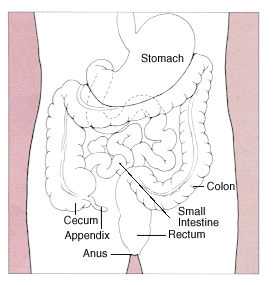Small intestine

In biology the small intestine is the part of the gastrointestinal tract between the stomach and the large intestine. In humans over 5 years old it is 270 to 290 cm long. It is divided into three structural parts: duodenum, jejunum and ileum. The duodenal length is approximately 20 cm, while the jejunum and ileum measure in at 100-110 cm and 150-160 cm, respectively. Food from the stomach is allowed into the duodenum by a muscle called the pylorus, or pyloric sphincter, and is then pushed through the small intestine by a process of muscular contractions called peristalsis.
The small intestine is the site where most of the nutrients from ingested food is absorbed. It is covered in wrinkles which are called plicae circulara. These are considered permanent folds in the wall of the organ. They are distinct from rugae which are considered non-permanent or temporary fold which allow for distention and contraction. From the Plicae circulara project microscopic finger-like pieces of tissue called villi. The purpose of these wrinkles and projections is to increase surface area for absorption of nutrients. Furthermore, each villus is covered in microvilli, which again increase the surface area manyfold. Each villus contains a lacteal and capillaries. The lacteal absorbs the digested fat into the lymphatic system which will eventually drain into the circulatory system. The capillaries absorb all other digested nutrients. As well, the surface of the cells on the microvilli are covered with a brush border of proteins which helps to catch a molecule-thin layer of water within itself. This layer, called the "unstirred water layer," has a number of functions in absorption of nutrients.
Although the small intestine is much longer than the large intestine (typically 4-5 times longer), it is referred to as such due to its comparatively smaller diameter. On average, the diameter of the large intestine of an adult human measures approximately 3 times the diameter of the small intestine. Upon viewing accurate diagrams of the digestive system, non-medically trained personnel often initially express bemusement as to why the obviously longer portion of the digestive system is referred to as the small intestine.
Functions
The digestion of proteins into peptides and amino acids principally occurs in the stomach but some also occurs in the small intestine. The small intestine is where the most chemical digestion takes place; peptides are degraded into amino acids; lipids (fats) are degraded into fatty acids and glycerol; and carbohydrates are degraded into simple sugars (e.g., glucose).
Small Intestine Disorders
(see also gastroenterology)
- Small intestine cancer
- Small intestine obstruction ("high" mechanic ileus)
- Obstruction from external pressure
- Obstruction by masses in the lumen (foreign bodies, bezoar, gallstones)
- Paralytic ileus
- Maropthisis
- Crohn's disease
- Celiac disease
- Carcinoid
- Meckel's Diverticulum
- Gastric dumping syndrome
- Infectious diseases
- Mesenteric ischemia
- Short bowel syndrome
- Inguinal hernia
References
Solomon et. al (2002) Biology Sixth Edition, Brooks-Cole/Thomson Learning ISBN 0-03-033503-5
